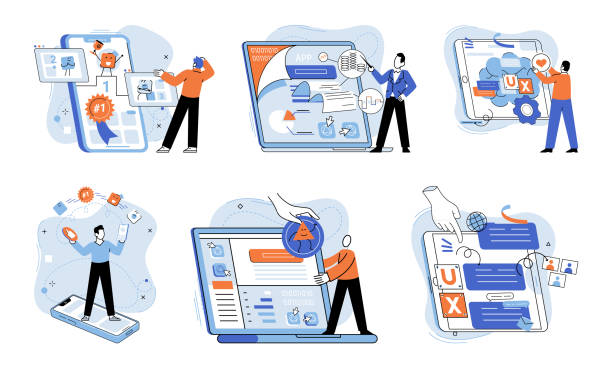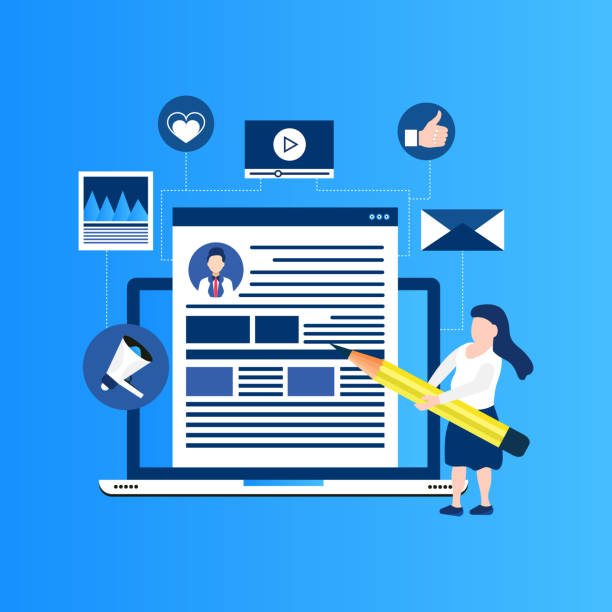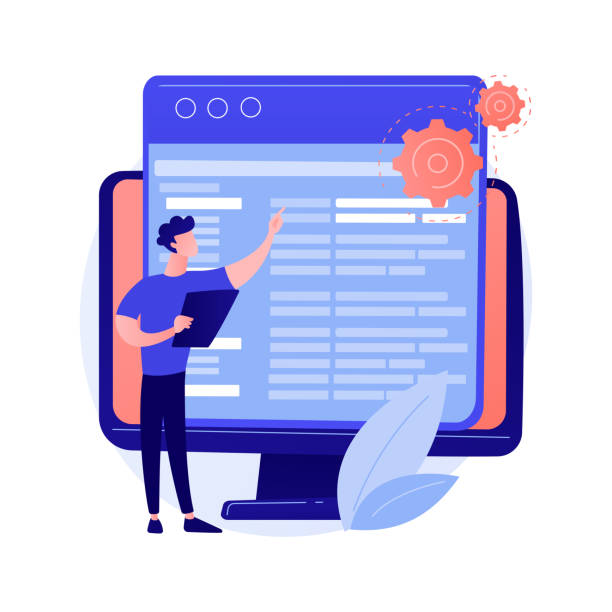The Unparalleled Importance of Fast Website Design in Today’s World

In the fast-paced world of #Internet and #IntenseBusinessCompetition, fast website design is no longer a luxury, but a vital necessity.
Today’s users are more impatient than ever and expect websites to load in a fraction of a second.
Any small delay in page loading can lead to losing visitors, decreasing conversion rates, and ultimately, financial loss.
Studies have shown that even a one-second delay in page loading time can lead to a significant decrease in user satisfaction and an increase in the bounce rate.
Therefore, increasing website loading speed not only improves user experience but also directly impacts your SEO and website ranking in search engines like Google.
Google gives special priority to high-speed websites, which significantly helps your visibility in search results.
The focus on fast website design should be a priority at all stages of website development, from choosing hosting to optimizing codes and images.
This is a long-term investment whose returns are clearly visible in customer acquisition and increased sales.
Are you tired of your company’s website not being seen as it deserves, losing potential customers? Solve this problem forever with professional and effective website design by Rasaweb!
✅ Enhance brand credibility and gain customer trust
✅ Attract targeted sales leads
⚡ Contact us now for a free consultation!
Key Factors Influencing Website Loading Speed

To achieve a high-performance website, it’s essential to understand the various factors that affect loading speed.
The first and perhaps most crucial factor is hosting quality.
A slow server or an overcrowded shared host can severely reduce your site’s speed.
The type of website coding also plays a vital role; heavy, repetitive, or unoptimized code can increase processing time and lead to a slow website.
The size of images and multimedia files is another important factor; high-volume images, without proper compression, place a heavy load on the server and user bandwidth.
The number and size of scripts and CSS files are also important; the more requests to the server, the longer the loading time.
Excessive use of plugins and add-ons, especially those not well-coded, can significantly decrease website speed.
Understanding these factors and optimizing each of them is crucial for fast website design and ensures that your site leads in digital competition.
Methods for Optimizing Images and Media to Increase Speed

One of the biggest factors slowing down a website is the large size of images and media files.
For achieving fast website design, image optimization is indispensable.
The first step is to compress images without significant loss of quality.
New formats like WebP have smaller file sizes compared to JPEG and PNG and can dramatically increase loading speed.
Also, using appropriate image sizes is very important; there’s no need to upload an image with a width of 2000 pixels into a space that is only 500 pixels wide.
“Lazy Loading” is also an excellent solution that loads images only when the user scrolls to the relevant section, not from the beginning.
This significantly improves initial loading speed, especially on long pages with many images.
Using a CDN (Content Delivery Network) for images and other media files can also help distribute content from the closest server to the user, increasing loading speed.
These measures combined can make a significant difference in website performance and are essential for anyone seeking a high-speed website.
| Optimization Method | Description | Advantages | Potential Disadvantages |
|---|---|---|---|
| Lossless Compression | Reduces file size without losing pixel quality. | Preserves image quality, reduces size by up to 30%. | Less size reduction compared to lossy compression. |
| Lossy Compression | Reduces file size by removing some non-essential visual data. | High size reduction (up to 90% for JPEG), excellent loading speed. | Potential slight visual quality degradation. |
| WebP Format | Modern image format developed by Google. | Smaller size than JPEG/PNG with similar quality, supports transparency. | Full compatibility with all older browsers may not be possible (but improving). |
| Lazy Loading | Loads images only when they enter the user’s viewport. | Reduces initial page load time, saves bandwidth. | Requires correct implementation, may disrupt user experience in rare cases. |
Code Optimization and Caching for Performance Enhancement

After image optimization, the next step towards fast website design is to focus on code and caching mechanisms.
One of the first actions is Minification of CSS, JavaScript, and HTML files.
This process involves removing unnecessary characters such as white spaces, new lines, and comments from the code, which directly reduces file sizes and speeds up loading time.
Another point is combining CSS and JavaScript files to reduce the number of HTTP requests to the server.
Each additional request to the server requires more time to respond.
Gzip compression is also a very effective method to reduce the size of files transferred from the server to the user’s browser.
This compression can reduce file sizes by up to 70%.
Furthermore, using Caching mechanisms plays a vital role in increasing website loading speed.
Browser caching allows the user’s browser to store static site files (such as images, CSS, and JS) locally.
This means that on subsequent visits, the browser does not need to re-download these files from the server, which significantly increases speed.
Server caching and Object Caching can also reduce the server’s processing load and improve response time by storing database query results or generated HTML pages.
These technical measures form the backbone of a fast website design.
Are you bothered by losing customers due to your e-commerce site’s outdated appearance or slow speed? The expert Rasaweb team solves these problems with professional e-commerce website design!
✅ Increase customer trust and your brand’s credibility
✅ Stunning speed and excellent user experience
Get a free consultation with Rasaweb right now ⚡
Choosing the Right Hosting and Infrastructure for Speed

Choosing appropriate hosting is the cornerstone of fast website design and is often overlooked.
Even the best code and image optimizations cannot compensate for a slow and inadequate server.
To achieve a high-speed website, you should look for a provider that offers powerful servers, sufficient bandwidth, and optimized network infrastructure.
Cheap shared hosts, while cost-effective, typically have limited resources and can severely reduce your site’s speed as traffic on other sites on the same server increases.
Better options include VPS (Virtual Private Server) or dedicated servers, which provide guaranteed resources.
For larger and high-traffic websites, Cloud Hosting is also an excellent option that provides high scalability and flexibility.
Additionally, using a CDN (Content Delivery Network) is a powerful solution for distributing your site’s static content (such as images, CSS, and JavaScript) across multiple servers worldwide.
When a user accesses a site, the CDN delivers the content from the server closest to them, which significantly reduces loading time and helps you achieve a fast website design.
The Impact of Website Speed on User Experience and SEO

Website loading speed is not just a technical metric, but a critical factor in User Experience (UX) and Search Engine Optimization (SEO).
Today’s users are accustomed to speed, and if a website loads slowly, they quickly abandon it and turn to another competitor.
This leads to an increased bounce rate, which sends negative signals to search engines and can lower your site’s ranking.
From an SEO perspective, Google has officially stated that page speed is a ranking factor.
A high-performance website not only helps achieve a better ranking in search results but also improves the search engine’s crawl rate.
This means that Google bots can index more pages of your site in less time.
Furthermore, speed directly impacts Google’s Core Web Vitals metrics, which include LCP (Largest Contentful Paint), FID (First Input Delay), and CLS (Cumulative Layout Shift).
Improving these metrics is not only vital for SEO but also provides a smoother and more enjoyable user experience for visitors.
Consequently, focusing on fast website design is a win-win strategy for any business.
Speed Measurement Tools and Result Interpretation

To ensure that your efforts towards fast website design have been fruitful, using speed measurement tools is crucial.
These tools help you identify your site’s weaknesses and monitor performance metrics.
The most popular of these tools include Google PageSpeed Insights, GTmetrix, and Pingdom Tools.
Google PageSpeed Insights provides a score from 0 to 100 for your site’s mobile and desktop speed and offers suggestions for improvement.
GTmetrix displays more detailed information, including full page load time, number of requests, and YSlow and PageSpeed scores.
Pingdom Tools also provides an overview of site performance, page size, and loading times for various components.
When interpreting results, look for items that have the greatest impact on speed, such as large image sizes, render-blocking codes, or slow server response.
These tools not only help you find existing problems but also provide practical guidance for increasing website loading speed and clarify the next steps for a fast website design.
| Tool | Main Focus | Key Features | Strengths |
|---|---|---|---|
| Google PageSpeed Insights | Core Web Vitals and SEO | Scoring (0-100), optimization recommendations, real-world data (Field Data) | Most reliable source for Google SEO, simple and easy to understand. |
| GTmetrix | Overall performance and component breakdown | Comprehensive Waterfall Chart report, PageSpeed and YSlow scores, loading video. | In-depth analysis and precise problem identification, ability to change test server. |
| Pingdom Tools | Load time and requests | Overall load time report, waterfall chart, component breakdown by content type. | Simple and fast for a general overview, multiple test servers. |
| WebPageTest | Advanced and custom tests | Multiple runs, testing from various locations, network speed simulation, API. | Very powerful and flexible for developers and specialists. |
Common Mistakes That Slow Down Your Website

On the path to achieving fast website design, avoiding certain common mistakes is as important as implementing correct optimizations.
One of the biggest errors is neglecting image sizes and failing to optimize them; loading large-dimension images in an inappropriate format can, by itself, cause severe site sluggishness.
Excessive use of heavy and unoptimized plugins or themes, especially in content management systems like WordPress, is another factor reducing speed.
Each extra plugin or theme adds more CSS and JavaScript code to the site and increases HTTP requests.
Failure to use caching, whether browser caching or server caching, is another common mistake that hurts loading speed.
Every time a user visits your site, they have to load all content from scratch.
Choosing cheap and unsuitable hosting is also one of the biggest mistakes; low-quality shared hosting or a server with limited resources can severely degrade site performance.
Lack of database optimization, excessive and heavy redirects, and failure to compress CSS and JavaScript codes are other factors that can unintentionally lead to site slowness.
Understanding and avoiding these mistakes are crucial for achieving a high-speed website.
Are you tired of your company’s website not being seen as it deserves, losing potential customers? Solve this problem forever with professional and effective website design by Rasaweb!
✅ Enhance brand credibility and gain customer trust
✅ Attract targeted sales leads
⚡ Contact us now for a free consultation!
The Future of Fast Website Design and Core Web Vitals

The future of fast website design is increasingly linked to the concepts of Core Web Vitals and Google’s focus on user experience.
Google has explicitly stated that Core Web Vitals will gain increasing importance as SEO ranking metrics.
These metrics include LCP (Largest Contentful Paint), which measures the loading time of the largest visual content on the page; FID (First Input Delay), which measures the site’s responsiveness to the first user interaction; and CLS (Cumulative Layout Shift), which assesses the visual stability of the page.
Focusing on these three metrics shifts web developers’ approach towards optimizing website speed for actual user experience, not just tool scores.
This means that not only should fast loading be considered, but also ensuring that the site quickly responds to user interactions and its elements do not unexpectedly shift after loading.
Technologies like AMP (Accelerated Mobile Pages) and PWA (Progressive Web Apps) also play a significant role in this regard, moving towards fast website design for mobile and various devices by providing an almost instant experience.
Developers should continuously monitor these metrics and align their strategies for increasing loading speed with changes in Google’s algorithms.
Final Checklist for a High-Speed Website

To ensure your website achieves maximum speed and efficiency, a comprehensive checklist is essential.
These steps guarantee that you have covered all critical aspects of fast website design:
- Optimal Hosting: Ensure you use a reputable hosting provider with high-speed servers (preferably VPS or cloud).
- Use of CDN: Utilize a CDN to distribute your site’s static content worldwide.
- Image Optimization: Compress all images, use modern formats like WebP, and enable Lazy Loading.
- Code Minification: Minify CSS, JavaScript, and HTML files to reduce their size.
- Strong Caching: Properly implement browser caching, server caching, and object caching for faster reloads.
- Gzip Compression: Ensure Gzip compression is enabled on your server.
- Remove Excessive Redirects: Eliminate unnecessary redirects or minimize their number.
- Database Optimization: Regularly clean and optimize your site’s database.
- Number of HTTP Requests: Reduce the number of site requests to the server.
- Continuous Monitoring: Regularly monitor your site’s speed with tools like Google PageSpeed Insights and GTmetrix.
By adhering to this checklist, you can ensure that your website will be a high-performance website and provide a seamless user experience.
These measures not only help increase loading speed but ultimately lead to the success of your online business, as fast website design is now more than ever the key to success.
Frequently Asked Questions
| Question | Answer |
|---|---|
| What is fast website design? | The process of building a website that loads quickly and provides a smooth user experience. |
| Why is website speed important? | Improved user experience, reduced bounce rate, increased conversion rate, and better search engine rankings (SEO). |
| What factors affect website speed? | Image size, number of HTTP requests, code optimization (HTML, CSS, JS), hosting speed, and browser caching. |
| How can website speed be improved? | Optimizing images, compressing files, using caching, choosing appropriate hosting, and reducing unnecessary plugins. |
| How do images affect website speed? | Large or improperly formatted images can significantly increase page loading time. |
| What is the role of JavaScript and CSS in website speed? | Unoptimized, large, or render-blocking codes can reduce page rendering speed. |
| How much does hosting affect website speed? | The speed and quality of the hosting server directly impact the website’s response time and initial loading speed. |
| What tools are available to check website speed? | Google PageSpeed Insights, GTmetrix, Pingdom Tools are common tools. |
| What are the benefits of a fast website? | Greater user satisfaction, reduced bounce rate, increased time on site, and improved Google search rankings (SEO). |
| What are common mistakes that slow down a website? | Using unoptimized images, bulky and disorganized code, excessive use of plugins, and not using caching. |
And other services of Rasaweb Advertising Agency in the field of advertising
Smart Sales Automation: A combination of creativity and technology to increase website traffic through intelligent data analysis.
Smart Google Ads: An effective tool to attract customers with the help of Google ad management.
Smart Website Development: A dedicated service for digital branding growth based on attractive UI design.
Smart Advertising Campaign: A fast and efficient solution for online growth focusing on intelligent data analysis.
Smart Conversion Rate Optimization: Designed for businesses seeking campaign management through the use of real data.
And over hundreds of other services in the field of internet advertising, advertising consultation, and organizational solutions
Internet Advertising | Advertising Strategy | Advertorials
Resources
Increase Website Speed
What is Website Optimization?
Website Optimization for Performance Improvement
Professional Website Design Checklist
? To achieve your business’s big goals in the digital world, Rasaweb Digital Marketing Agency is by your side with a professional and result-oriented approach. From personal website design to comprehensive SEO and content marketing strategies, we provide everything you need for visibility and growth.
📍 Tehran, Mirdamad Street, next to Central Bank, Kazeroun South Alley, Ramin Alley No. 6


